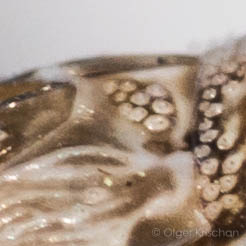During a bee hunt I encountered this insect on Rododendron. It is an immature 5th instar nymph, of the cicade Issus coleoptratus [1, 2, 3].
1. DISTRIBUTION
It is a common species in the Netherlands.
2. BEHAVIOUR
2.1. ACTIVITY
The nymph instars 2 to 4 probably overwinter, possibly instar 5 as well [2]. Adults appear in May and can be found until November [2].
These animals cannot fly but hop instead.
2.2. DEVELOPMENT
It is still unclear wether the species produces one or more generation each year and wether the development follows an irregular pattern. This is apparent from the different nymph stages that can be found simultaneously [2].
2.2. FOOD
These cicadae feed on phloem, cells on the inside of the bark that transport the nutrients in the tree, from different tree species like:
- Tilia
- Oak
- Maple
- Birch
- Elm
- Common hazel
The Rododendron in which the nymph sat grows next to a Hazel tree.
2.3. DEFENSE MECHANISM
The light blue-ish filaments at the end of the abdominal tip are made of wax that is secreted from glands. The purpose is possibly related to defense against parasites and predators as those will attack the threads which gives the nymph an opportunity to flee [4]. These waxy structures are a well known characteristic in many cicadae nymphs [5].
3. IDENTIFICATION
3.1. Nymphs
The nymphs of the genus Issus can be idenitfied by [1]:
- Postclypeus (part of the lower half face) lies below the eyes
- Vertical keels on face (frons)
- Vertex less than twice longer than wide
In the Netherlands exist two species from this genus, I. coleoptratus and I. muscaeformis. The nymphs of both species resemble a lot but can be distinguished based on the following characteristics:
- Frons I. coleoptratus has a medial horizontally light colored banding instead of a dark [1]
- The sensory pits in the frontwing pad are in I. coleoptratus large, clearly articulated and typically in a group of 10, instead of smaller, less clearly separated pits in a typical grouping of 7 [1].
This specimen is a 5th instar which can be determined based on the development of frontwing pad, of which the tip reaches up to the base of Tergite III.
3.2. Adults
The adults have a disc-like spot on the forntal wing [1].


In frontal view the species has a clear dark zone directly beneath the vertex[1], the top side of the head.
Literature
1 ZENNER, Gudrun; STÖCKMANN, Marlies; NIEDRINGHAUS, Rolf. Preliminary key to the nymphs of the families and subfamilies of the German Auchenorrhyncha fauna. Cicadina, 2005, 8: 59-78.2 P.F. Whitehead & R.S. Key, 2010, "Observations on British Issus (Hemiptera, Issidae) with reference to development, periodicity and ecology", Worcestershire Record | 29 (November 2010) page:23-27 | Worcestershire Biological Records Centre & Worcestershire Recorders
3 Nederlands Soortenregister
4 RESH, Vincent H.; CARDÉ, Ring T. (ed.). Encyclopedia of insects. Academic press, 2009.
5 HAMILTON, KG Andrew. Making sense of Fulgoroidea (Hemiptera). Cicadina, 2011, 12: 57-80.











